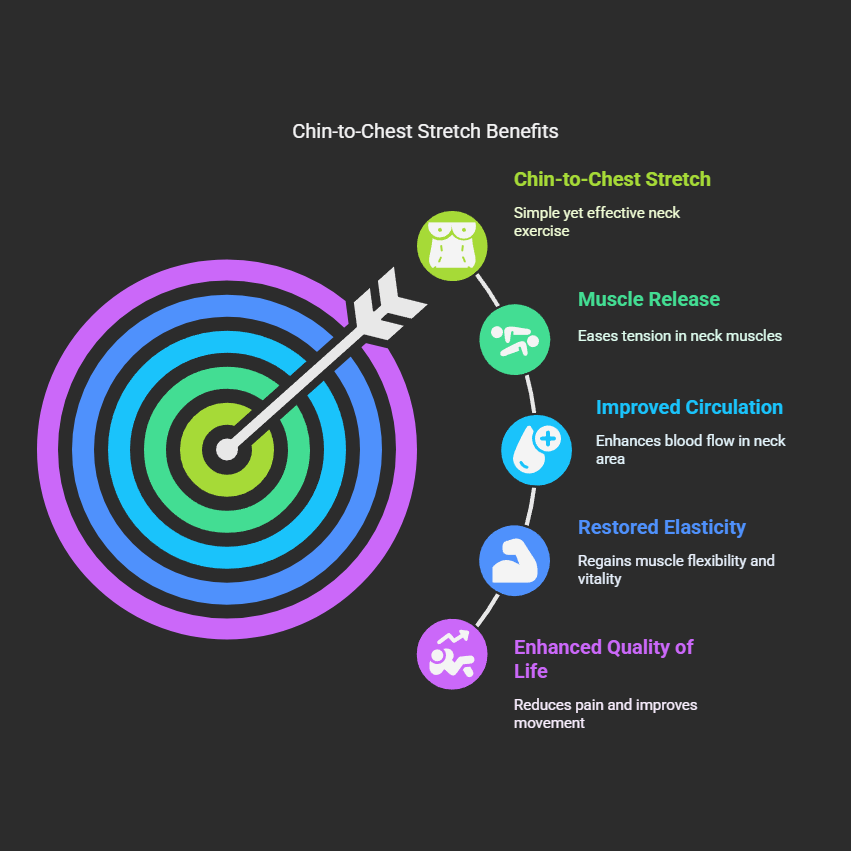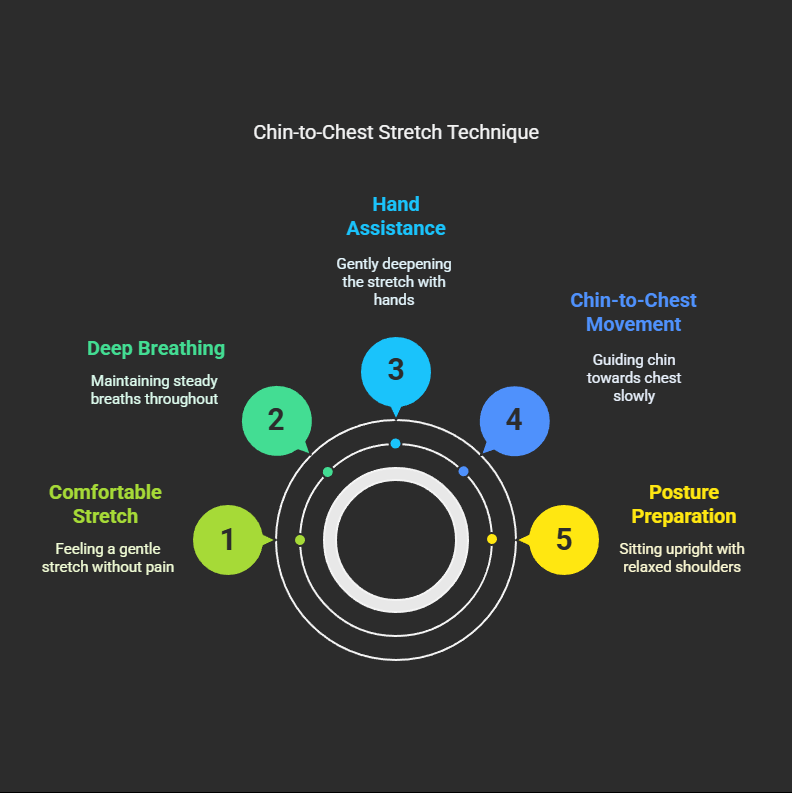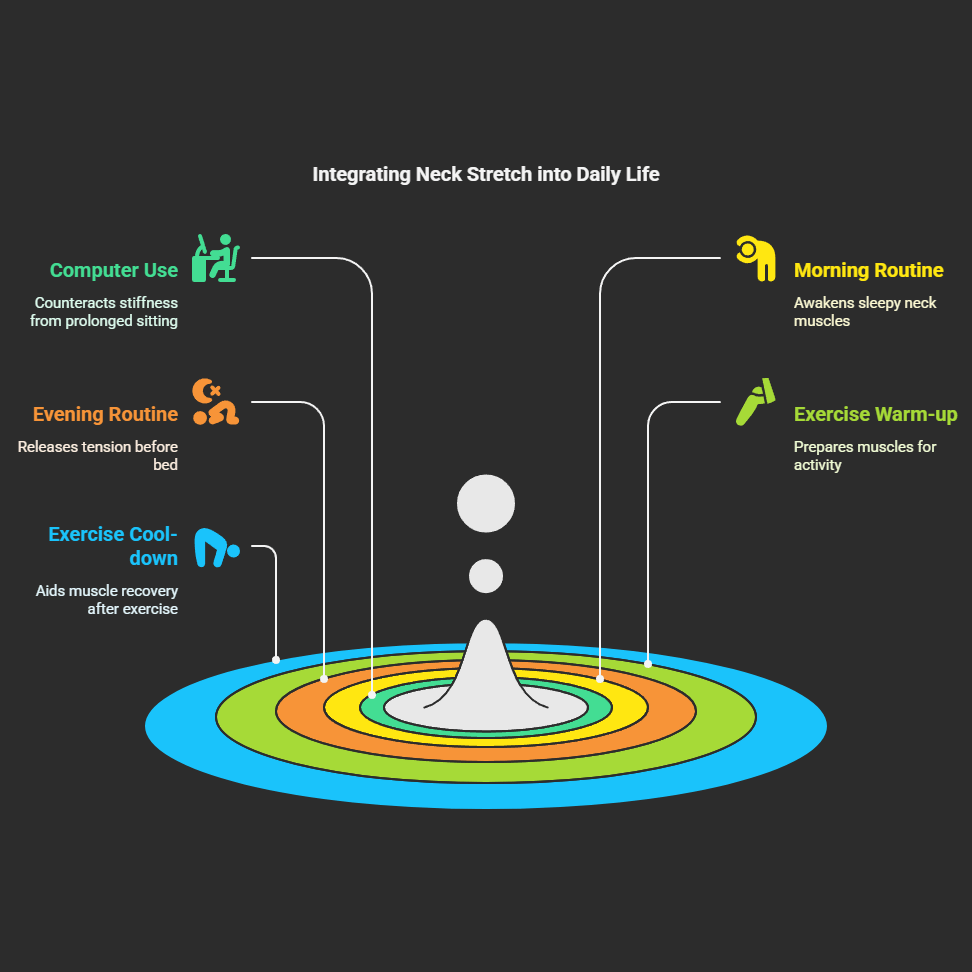Hey, everyone! I'm your dedicated massage therapist. In this age where we're constantly 'glued to our devices,' do you also often experience tightness, soreness, and discomfort in your neck and shoulders, or perhaps even occasional dizziness or a muddled head? Prolonged periods of looking down at our phones or being hunched over computers are daily habits that quietly put immense pressure on our cervical spine, making the commonly known 'Turtle Neck' or 'Text Neck' increasingly prevalent. Today, I want to share with you all a simple yet highly effective stretch—the 'Neck Forward Flexion Stretch,' which is also commonly known as the 'Chin-to-Chest' movement. Don't underestimate this movement; performing it correctly will be a great asset on your path to a 'Happy Healthy Life' and in keeping neck and shoulder problems at bay!
This 'Chin-to-Chest' stretch may sound simple, but for the muscle groups at the back of our neck, it's truly a journey of deep release. Imagine, the back of our neck, extending from the base of the skull down to the upper back, is layered with multiple muscle groups, such as the commonly known upper trapezius, the deeper splenius and semispinalis muscles, and even the deeper suboccipital muscles. These muscles work hard all day long, supporting the weight of our head and contending with the challenges of various poor postures. When these muscles are chronically tense and shortened, they not only cause pain but also restrict neck movement, impacting our quality of life. Through this 'Chin-to-Chest' movement, we gently lengthen these tight muscles, promote blood circulation, and help them regain their original elasticity and vitality.

So, how exactly do you perform this amazing stretch correctly? First, find a stable chair and sit upright with both feet flat on the floor. Feel your spine naturally extending upwards, but keep your shoulders relaxed, gently drawing them back and down. Next, slowly and gently guide your chin towards your chest. Imagine the back of your neck lengthening vertebra by vertebra, or try to make a slight 'double chin' movement. If you want to deepen the stretch, you can gently place both hands on the back of your head (at the occiput). Allow the natural weight of your hands to provide a little gentle assistance, but remember, absolutely do not forcefully pull your head down! You should feel a comfortable stretching sensation at the back of your neck, not sharp pain. Hold this position for 15 to 30 seconds, remembering to maintain deep, steady breathing throughout. Then, slowly return to the starting position.

In my professional experience, I've observed that many people tend to make small mistakes when doing this stretch, which can reduce its effectiveness and may even cause discomfort. The most common mistake is 'using excessive force,' thinking that more pain equals more gain, but this can actually lead to minor muscle strains. Remember, the key to effective stretching is to be 'gentle and sustained.' Another common issue is 'slouching or hunching the back,' where other parts of the body try to 'help out,' thereby greatly diminishing the effectiveness of the neck stretch. What we need to do is focus on the flexion of the cervical spine while keeping the torso stable. Also, don't forget that 'shrugging your shoulders' is another bad habit; it will only make your trapezius muscles tighter. Throughout the entire process, ensure your breathing remains smooth and natural. Absolutely do not hold your breath, as this will make your body even tenser!
As long as you perform the 'Chin-to-Chest' stretch correctly and regularly, the benefits it can bring are quite numerous! The most immediate benefits you'll feel are relief from neck stiffness and pain, especially for office workers who maintain fixed postures for long periods and for those who frequently look down at their devices. Furthermore, consistent stretching helps to increase the range of motion and flexibility of your cervical spine, allowing your head and neck to move more freely and with greater ease. Many people don't realize that excessive tension in the posterior neck muscles is actually one of the main culprits behind poor postures like forward head posture. Relaxing these muscles also positively contributes to improving overall posture. Even some 'tension headaches' caused by neck muscle tension may be alleviated to a certain extent through this stretch!
Although this stretch offers many benefits, as a professional massage therapist, I must remind everyone of some important safety precautions. If you have an acute neck injury, such as a recent sprain or strain, or more serious conditions like a fracture or dislocation, please absolutely avoid performing this stretch and seek immediate medical assistance. If you have known conditions such as spinal instability, severe osteoporosis, or bone tumors, or if you experience 'warning signs' (red flags) like dizziness, double vision, difficulty swallowing, nausea, worsening numbness or weakness in your limbs, or changes in bowel or bladder habits, these could all be signs of more serious underlying problems. Do not perform this stretch on your own; instead, consult a doctor promptly. Remember, stretching should feel comfortable. Any movement that causes sharp pain or worsens existing symptoms should be stopped immediately.
You can also make slight adjustments to this basic stretch based on how you feel. For example, before doing the 'Chin-to-Chest' stretch, first gently retract your chin horizontally backward (imagine making a double chin, but without nodding your head down). This 'chin tuck' movement can more specifically target and stretch the 'suboccipital muscles' at the very top of our neck, near the base of the skull. Alternatively, after bringing your chin close to your chest, you can then gently tilt your head slightly towards your left or right shoulder. This can place more emphasis on stretching the levator scapulae and other muscles on the opposite side. If you feel that the unassisted stretch isn't providing a noticeable sensation, you can also try a 'towel-assisted' modification. Roll up a small towel, place it behind your neck, and hold both ends with your hands. As you bring your chin towards your chest, gently pull the towel forward and slightly upward with your hands to provide supportive flexion.
It's actually not difficult at all to incorporate this simple stretch into your daily life! For those who use a computer for long periods, I strongly recommend getting up and moving around every hour and, while you're at it, doing a few sets of the 'Chin-to-Chest' stretch, holding each for 15-30 seconds and repeating 2-4 times. This can effectively counteract the muscle stiffness caused by prolonged static postures. You can also use this stretch after waking up in the morning to awaken your sleepy neck, or before bed at night to release the neck tension accumulated throughout the day. If you have a regular exercise routine, you can incorporate it into your warm-up phase before exercise as a dynamic stretch with shorter holds, or during your cool-down phase after exercise as a static stretch with longer holds to aid muscle recovery.

Of course, while the 'Chin-to-Chest' stretch is very useful, it's not a panacea. To achieve truly healthy neck and shoulders, a more comprehensive care plan is necessary. This includes consistently paying attention to maintaining good posture in daily life and avoiding looking down for prolonged periods. At the same time, moderately strengthening the deep neck flexors and scapular stabilizing muscles is also very important, as they provide more stable support for our cervical spine. Don't forget to review your work environment—for example, adjusting your computer monitor height to ensure it is level with your line of sight. Furthermore, regular professional massage can more deeply relax tight muscles and fascia, improve circulation, and allow a therapist to assess your condition and provide personalized advice.
In conclusion, the Neck Forward Flexion ('Chin-to-Chest') stretch is a very practical and easy-to-use self-care tool. It can effectively help relieve tension in the posterior neck muscles, improve range of motion, and add a measure of comfort and ease to our 'Happy Healthy Life.' Remember to use the correct techniques, pay attention to your body's responses, avoid contraindicated situations, and incorporate it into your daily routine. If neck discomfort persists, or if you have any concerns, please be sure to consult your doctor, a physical therapist, or a massage therapist like myself. Let's gently care for our cervical spine together and enjoy a healthy, unrestrained life!
